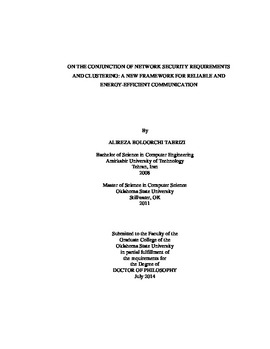| dc.contributor.advisor | Samadzadeh, M. H. | |
| dc.contributor.author | Boloorchi Tabrizi, Alireza | |
| dc.date.accessioned | 2015-06-17T20:04:57Z | |
| dc.date.available | 2015-06-17T20:04:57Z | |
| dc.date.issued | 2014-07 | |
| dc.identifier.uri | https://hdl.handle.net/11244/14735 | |
| dc.description.abstract | Several perspectives of network security and energy efficiency were investigated and a scheme is proposed for each. A new approach is introduced to enhance communication security among nodes based on the threshold secret sharing technique and traditional symmetric key management. In the proposed scheme, key distribution is online, which means key management is conducted whenever a message needs to be communicated. | |
| dc.description.abstract | The cost and security analyses of the proposed scheme showed that its use enhances communication security among the nodes in networks that operate in hostile environments compared to related work. Another aspect of security is the storage and retrieval of data in energy-sensitive networks. The proposed scheme aims to provide an energy-efficient and secure in-network storage and retrieval protocol that could be applied to Wireless Sensor Networks. A predictive method is also proposed to adaptively instantiate the appropriate parameters for the threshold secret sharing technique. Simulations were utilized to illustrate the effect of several network parameters on energy consumption and to come up with optimal value recommendations for the parameters of the proposed secret sharing scheme. Analysis and experimentation showed that, by using the proposed technique, the confidentiality, dependability, and integrity of the sensed data are enhanced with fairly low communicational and computational overhead. | |
| dc.description.abstract | Collaborating for in-network processing is another issue (along with security) that is a concern for energy-sensitive networks. This part of the proposed framework concerns introducing a new clustering algorithm to enhance the efficiency of resource assignment for the purpose of assigning just enough components to each service-requesting application while minimizing the overall distances among the cooperating components. The proposed algorithm groups the components of a network into different-size clusters and results in a clustered network in which most of the components in a cluster, which provides service to an application, are busy. | |
| dc.format | application/pdf | |
| dc.language | en_US | |
| dc.rights | Copyright is held by the author who has granted the Oklahoma State University Library the non-exclusive right to share this material in its institutional repository. Contact Digital Library Services at lib-dls@okstate.edu or 405-744-9161 for the permission policy on the use, reproduction or distribution of this material. | |
| dc.title | On the conjunction of network security requirements and clustering: A new framework for reliable and energy-efficient communication | |
| dc.contributor.committeeMember | Chen, Tingting | |
| dc.contributor.committeeMember | Thomas, Johnson | |
| dc.contributor.committeeMember | Weiser, Mike | |
| osu.filename | BoloorchiTabrizi_okstate_0664D_13614.pdf | |
| osu.accesstype | Open Access | |
| dc.type.genre | Dissertation | |
| dc.type.material | Text | |
| dc.subject.keywords | clustering | |
| dc.subject.keywords | network | |
| dc.subject.keywords | parallelism | |
| dc.subject.keywords | security | |
| dc.subject.keywords | wireless sensor network | |
| thesis.degree.discipline | Computer Science | |
| thesis.degree.grantor | Oklahoma State University | |
